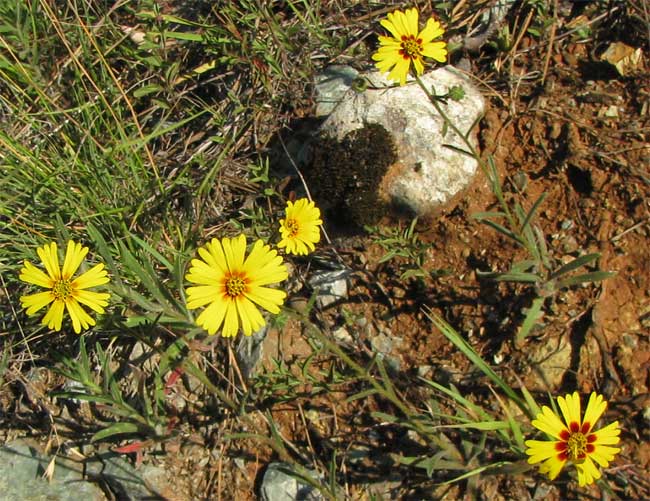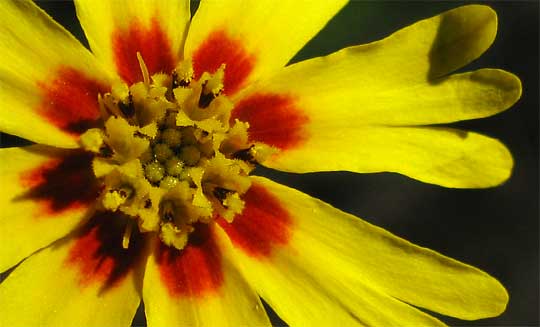Excerpts from Jim Conrad's
Naturalist Newsletter

from the the July 12, 2009 Newsletter, issued from the Siskiyou Mountains west of Grants Pass, Oregon:
TARWEED ENCHANTMENT
Along my gravel jogging road, at the bottom of a steep hill, there's a weedy spot that each morning almost takes my breath because of its sheer beauty. Especially this week when the silvery Moon hung suspended in the western sky, this dewy spot in dim early-morning light absolutely glowed with thousands of close-together, yellow, daisy-like flowers, all their heads turned toward the sun soon to rise on the eastern horizon. One morning I returned there with my camera just as the sun's first rays streamed onto the flowers, their faces flat into the sun, a few shown above. Those are Tarweeds, sometimes called Common or Wild Madia, MADIA ELEGANS. A close-up a flower-head is below:

"Flower-head" instead of "flower" because Tarweeds are members of the Composite or Sunflower Family, so in the last picture you saw lots of flowers gathered into a flower-like cluster, not just one flower. Around the head's periphery radiate several flat, three-lobed "ray flowers" while the center is occupied by several five-lobed, conical "disk flowers." Among Tarweeds only the ray flowers produce fruits; the disk flowers only produce pollen. The fruits can be pressed for oil or roasted and ground into flour, though they're smaller than rice grains and each flower only produces as many as it has ray flowers.
Jogging beside the little colony of Tarweeds, I can smell a pungent, medicinal scent even though I'm not treading any. If you walk among the foot-tall plants your leg hairs get gummy and stick together. Our Tarweeds are densely covered with long hairs tipped with glands that secrete a sticky, resinlike substance. You can see the gland-tipped hairs below:

I specify "our Tarweeds" because this is a very variable species with four recognized varieties, and even the varieties vary a great deal within themselves. Some Tarweed forms don't have the gland-tipped hairs, some don't have the dark splotches at the ray-flowers' bases, etc.
In mid afternoons when it's particularly hot and dry, if you return to the Tarweed spot you won't see a single blossom, for the flower heads close and the rays shrivel drastically when it's very hot and dry. Each morning when I see so many fresh blossoms vivaciously facing into the sun when the previous afternoon there'd been nothing to see, it seems nothing short of miraculous, and I guess it is.
Tarweeds are native wildflowers occurring in grasslands, shrublands, woodlands, and disturbed sites from Washington State to Mexico's Baja California, east into Nevada.